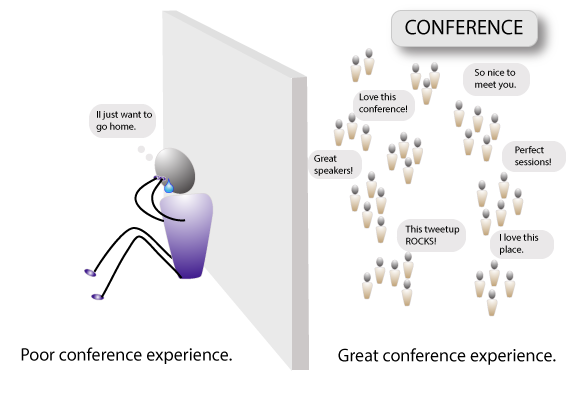
As the 2012 meeting of the American Sociological Association (#ASA2012) kicks into gear, I want to use this post to start a conversation about a somewhat-contentious topic: academics’ use of Twitter, particularly at conferences. I begin by extending some of what’s already been written on Cyborgology about the use of Twitter at conferences, and then consider reasons why some people may find Twitter use off-putting or intimidating at conferences. I close by considering what Twitter users in particular can do to ease the “Twitter tensions” at ASA by being more inclusive. The stakes here include far more than just “niceness”; they include as well an opportunity to shape the shifting landscape of scholarly knowledge production.
Before I begin, I need to make two disclosures; I also want to define a few terms, so that the conversation that follows is more accessible to people who aren’t familiar with Twitter. Disclosure No. 1 is that this year will be my first time attending an ASA; at the time of writing, my impressions of the “Twitter tension” at ASA in particular are based on reports from friends and colleagues rather than on first-hand experience. Disclosure No. 2 is that, like my Cyborgology colleagues, I’m a big fan of what we like to call augmented conferences, or conferences that make full use of Twitter and other digital media to enhance and expand conference participation both for those who can attend in person and for those who participate across geographic distance. (Readers who also see this type of model as the ideal conference may wish to skip the next two paragraphs, in which I explain some terminology relevant to backchannels and Twitter most generally.)
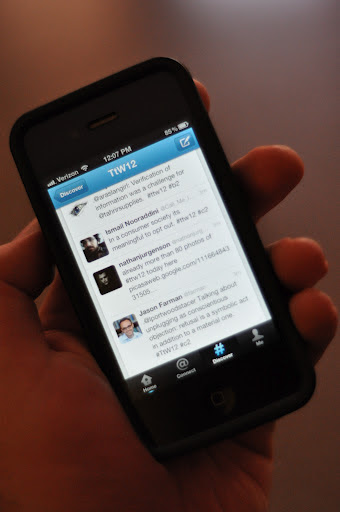
Augmented conferences frequently work to enhance participation through the use of backchannels, which are conversations about individual conference presentations or about the conference itself that take place in real-time through Twitter (and sometimes through other digital media). Threads of specific backchannel conversations are identified using hashtags, which are short bits of text with # in front of them (aka, #ASA2012). Hashtags are clickable links, and both Twitter users and non-users can follow a backchannel discussion by clicking on a hashtag or by entering the hashtag into the “search” field on Twitter; doing either will bring up all the tweets (or individual posts of 140 characters or less) that have that particular hashtag in them. The main hashtag for a big conference can become a bit chaotic, so presentation-specific backchannels are often marked with both the conference hashtag and a presentation-specific hashtag (you can see how this was done at Theorizing the Web 2012: in addition to the conference-specific hashtag #TtW12, each panel has its own specific hashtag listed in the program according to session number and room location).
So what’s a backchannel conversation like? Twitter users who are watching the presentation (either in the room or remotely, if the talk is livestreamed over the Internet) frequently quote or paraphrase the presenter’s points. A user who is live tweeting the presentation will attempt to transmit enough of the talk and following in-room discussion for someone who isn’t in the room (or watching online) to follow along; other users watching the presentation will tweet points they find particularly interesting, noteworthy, controversial, or enjoyable. Both users who are watching the presentation (in-room or via livestream) and those who are only following the backchannel will comment on and ask questions about points from the presentation.
Backchannel conversations often continue after a presentation ends, and if the presenter is a Twitter user as well, she’ll usually join in for a bit after her presentation is finished. A panel at an augmented conference may also have a backchannel moderator, whose job it is to live-tweet the presentations and to voice the best questions from the backchannel during in-room discussion; some intrepid speakers have also been known to field questions directly both from the room and from the backchannel simultaneously.
If you’ve never seen one happen, the truth is that a backchannel discussion is a pretty amazing thing. It allows people who can’t be physically present at a conference to participate, not just by making conference content available to them but by providing a way for them to add their voices to the discussions that take place as they are happening. Successful backchanneling also demands an intense engagement from in-room attendees, and therefore forces those who can be corporeally present to be intellectually present as well. One backchannel participant who clarifies a piece of presenter can improve the experience of attending a talk for unknown numbers of other participants, and a lively backchannel discussion can allow participants to identify key issues and questions before in-room discussion begins. All of these things help participants to make better use of limited in-room discussion time.
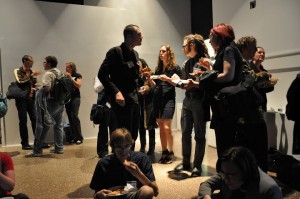
Backchannel discussions also allow conversation to continue after conference-weary bodies file out of stuffy conference rooms, or fly out from conference cities; some of us shy or introverted attendees may also find it easier to approach strangers in person after talking to them in a backchannel (just kidding—we all know there are no awkward sociologists). Backchanneling can therefore help to create and maintain the professional and personal relationships upon which survival in academia depend.
Perhaps most importantly, archived backchannel discussions represent an important form of conference proceedings, one that is more accessible by virtue of being both publically available online and (more often than not) written in the less “jargony” language that Twitter’s 140 character limit tends to demand. These versions of proceedings are accessible by availability and by design. When we take conference notes by live-tweeting instead of creating private digital or paper notes, we enact our commitment to reengaging academic sociology with the societies that surround it, to facilitating the spread of information, and to getting “out of the hotel conference room, and [into] the streets.” Participating in a backchannel is a political act, and in a certain sense, a backchannel discussion is a collective labor of love.
So now that ASA has wifi, why aren’t we all backchanneling? It turns out that not everyone thinks backchannels are so great. There’s been some friction at previous ASA meetings between attendees who use Twitter and attendees who don’t, and I think this is understandable. Even I admit that, in a way, Twitter can represent the worst of cultural speed-up. The expected response time on a critical tweet is a lot shorter than the expected response time on a critical journal article, and if one “follows” a good collection of people, Twitter can be an overwhelming assault of interesting ideas and articles, a personalized “data deluge.” Some presenters may be worried that wider, more rapid circulation of their unpublished work will lead not to increased opportunities for collaboration, but to getting “scooped”; others may fear discussing preliminary work they are not yet ready to commit to record. Given that the mantra is still “publish or perish,” the stakes can feel high.
There’s also the matter of presenting itself. In the age of Twitter, an anxious presenter must now worry not only about whether the computer users are taking notes or checking email, whether the notepad users are taking notes or doodling, and whether those people sitting quietly in the back row are actually sleeping, but also whether some of the audience is tweeting, and therefore not only ‘distracted’ but having a conversation of which the presenter herself is as-yet unaware. The presenter is, of course, always participating in the discussion; without her presentation, there would be no backchannel discussion at all! But we can acknowledge that presenting and backchanneling are different modes of participation, just as are presenting and attending, and that the difference between presenting and backchanneling in particular may be additionally disconcerting for speakers who are unfamiliar with Twitter and backchannels.
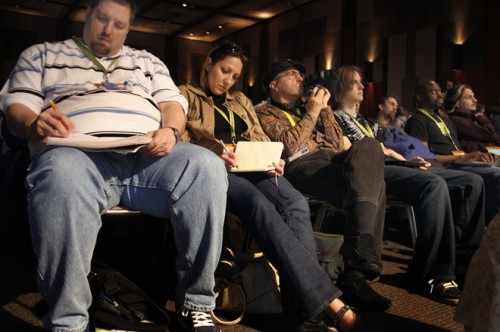
A non-user may feel as though a backchannel discussion of her presentation represents “passing notes during a talk, only if those notes were posted on a giant whiteboard behind the speaker so that everybody but her could read them.” Though a speaker can easily join the backchannel discussion following her presentation, she may in that moment want a drink or a nap (or both) far more than she wants to engage in digital discussion about her talk. Let’s admit, too, that it can be considerably more daunting (for user- and non-user presenters alike) to face a room that’s well prepared to ask critical questions instead of one that flounders for the first two-thirds of an in-room discussion period. Maybe this represents a drawbacks to moving past talks in which a speaker presents “to five bored attendees checking their email.”
Finally, given that new or unfamiliar technologies can irritating or intimidating in and of themselves, what percentage of ‘expert authorities’ want to risk losing face by fumbling with Twitter in front of some punkass hipster grad students? Though there are certainly some venerable figures who use and enjoy Twitter, perhaps it’s unsurprising that other academics with secure positions and established networks don’t see what bothering with Twitter would have to offer them. But why does any of this matter? Some of us love Twitter, some of us hate it, and some of us just don’t care; why is this worth writing a blog post about? Can’t the lovers love, and the haters hate, and all of us leave it at that?
In a word: No.
As David Banks (@DA_Banks), Sarah Wanenchak (@dynamicsymmetry), Nathan Jurgenson (@nathanjurgenson) & Pj Rey (@pjrey), and a number of others have argued, the old conference model needs to change, as do most of the models for how we academics circulate and disseminate information. Backchanneling represents one excellent way for academic conferences to take a step in the right direction, but at present those of us who feel that way are in the minority. Academia is notoriously slow to change, and “those entrenched in the old system, whose habits are better suited to yesteryear and who still have sufficient power to resist… any change” have little incentive to see the value that backchannels add to a conference. Therefore, I call for new tactics: I call for dialogue and outreach at ASA2012.
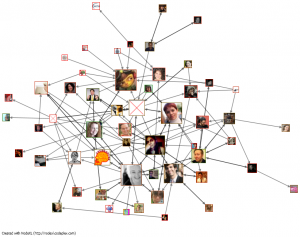
If you’re backchanneling this week, I challenge you to reach out to someone who isn’t backchanneling. Consider offering to share your screen with someone for a talk. Show someone a backchannel conversation following a presentation, and explain how backchanneling works. See if you can’t help someone sign up for Twitter. Try to answer questions about what you’re doing and why you’re doing it with patience, compassion, and humor (even when those things aren’t extended to you, because at least once they probably won’t be). Try not to be too bitingly sarcastic on Twitter when you see a presentation you disagree with, and if you must break out the industrial strength snark, consider keeping it off the #ASA2012 hashtag. Don’t publically make fun of people who aren’t as tech-savvy as you are (even if you did think that whole ASA2012 “app” thing was really funny). Remember that there are understandable reasons some people are skeptical of backchanneling, and see if you can contribute—even just once—to making augmented conferences seem a little less alien, off-putting, or intimidating to someone who doesn’t yet see augmented conferences the way you do.
As academics, we need to work first and foremost on being more accessible to society; we also need to work on being more accessible to each other. Backchanneling can help us with the former, and it has certainly helped some of us with the latter, but we need to go further. How can we accomplish this? Let’s start the conversation.
Whitney Erin Boesel is on Twitter (@phenatypical), and is more than happy to help you get on Twitter, too!
Unhappy conference image from http://idratherbewriting.com/2012/05/18/15-tips-for-a-successful-conference-experience/
Backchannel on mobile phone photo by Rob Wanenchak from https://thesocietypages.org/cyborgology/tag/theorizing-the-web/
Approaching sociologists at TtW12 photo from https://picasaweb.google.com/111664843315056907652/TheorizingTheWeb2012?authuser=0&feat=directlink#5731684385905961026
Taking or passing notes photo from http://www.movingfrommetowe.com/2008/03/12/when-a-conference-audience-gets-ugly-in-live-time/
New connections at TtW11 image from http://pjrey.wordpress.com/2011/04/19/reflections-on-theorizing-the-web/

Comments 12
collin — August 16, 2012
Thanks for this. I appreciate the level of detail and explanation here--I "attended" two conferences this summer through a combination of video streams and twitter feeds, and it really made me appreciate those conferences (and attendees) who work to augment the experience for others.
I think there's another layer to this as well, regardless of whether or not a person decides to be an active backchanneler, and that's approaching one's presentation differently. I wrote a little about this at the beginning of the summer, if you'll forgive the self link (http://www.cgbrooke.net/2012/05/27/the-tweetability-index/). TLDR, when we know that our audience may be tweeting, it should affect how we present our ideas, just as the difference between reading and listening does.
Thanks again,
cgb
MrTeacup — August 16, 2012
Whitney, I can't help but note a seeming contradiction between this post, and your last post about white flight and App.net. I am not extremely familiar with the debate about backchannels at the ASA conference, but from what I'm reading here, you seem to map the conflict about the technology on to a power struggle within academia. Is that a fair characterization? I'm sensing a narrative opposing the young insurgents vs. the old, entrenched establishment, something that we also often hear from the Silicon Valley digerati.
In your last post, you describe that group as "largely affluent white men with connections to the tech industry." I mostly agree with this description, and I find it fascinating that despite their relative privilege, consider themselves victims of an oppressive establishment. The primary complaint is the refusal of the establishment to acknowledge the insurgents' technological superiority, which has a tendency to bleed over into arrogance, or what has been called "nerd supremacy." One manifestation of this phenomenon is the elitism and bigotry you identify in your App.net blog post. A softer version is mockery of those who are not as adept with technology that you warn against in this blog post. Am I right in seeing parallels here? Is it fair to say that App.net is to Facebook as TtW is to the ASA conference? It's not a perfect analogy, but maybe there's a grain of truth there. I wonder what you think.
I deeply appreciated your account of the controversies with back-channels at your conference. I approach the issue as a designer and builder of technology tools, so when I hear that the majority of users are rejecting a tool, I hear that as a warning that something is broken with the tool. I want to know more from those users, understand their context, empathize with their perspective, because in all likelihood, the tool is not meeting their needs. My job exists because history is littered with technology projects that failed because they were rejected by the users, and it became clear that a more inclusive, democratic approach to building tools is necessary if we want them to succeed. This is more than just a sales job, it's about inviting users of technology to help make decisions about its design.
I worked on wiki software for several years, and few people outside of the industry realize how many core concepts from software engineering processes are embedded in wikis. One result is that wikis are more natural for software developers than they are for people from other backgrounds, so even though "anyone" can participate in a wiki, software developers tend to use it more, so their viewpoint tends to be the dominant one. I've noticed a tendency to account for user disengagement by resorting to quite crude concepts like technophobia or technophilia. For me, it's more useful to think about how people have developed ways of thinking and working that help them achieve their goals, and ask how we can build tools that support them in those goals.
Twitter was designed for hip 20-something geeks at SXSW. Is that an appropriate tool for middle-aged sociology professors at an academic conference? From what I'm hearing, the answer is no. To build a tool for them, we need humility, empathy and respect for their perspective, and a willingness to let go of the belief that we know our users' needs better than they do, and the desire to dictate what their goals ought to be.
ASA eve « Memoirs of a SLACer — August 16, 2012
[...] even the world!) head to Denver, here are a few things to keep you entertained: First, a post about making ASA better by using Twitter and other forms of digital communication (I think I joined Twitter once. I might have to dig out my [...]
Twitter isn’t a Backchannel (#ASA2012) » Cyborgology — August 17, 2012
[...] read. This isn’t going to be a post on why we should use Twitter at conferences, Whitney Boesel already did that more diplomatic than I could pull off. Anyways, framing it as ‘why do we continue to meet [...]
Toward A More Inclusive Backchannel: An Unusual Call To Action | Philosophy, Education, Technology | Scoop.it — August 19, 2012
[...] Academic conferences: the model needs to change. [...]
Toward A More Inclusive Backchannel: An Unusual Call To Action » Cyborgology | csid — August 20, 2012
[...] Toward A More Inclusive Backchannel: An Unusual Call To Action » Cyborgology. Share this:FacebookEmailPrint This entry was posted in Open Access, Public Philosophizing, [...]
Post-ASA Reflection: Gender, Networks, & Use of ASA Hashtags » Cyborgology — August 24, 2012
[...] the 2012 meeting of the American Sociological Association kicked off last week, I challenged those of us who tweet at conferences—or “backchannel”—to reach out to those who don’t. (Nathan Jurgenson has since made a [...]
Twitter Still Isn’t A Backchannel » Cyborgology — August 17, 2013
[...] York this last week, I was reminded of the post that I wrote last year before #ASA2012 in which I encouraged tweeting academics to reach out to non-tweeting academics to bridge the gap between those who participate on the conference [...]
Collecting Echoes | Digital Information & Technology Adventures — November 9, 2014
[…] from the speaker and distracts from the experience of presenting and listening, it is potentially alienating and can disinhibit hecklers. Whether welcomed or not they have changed the boundaries and […]